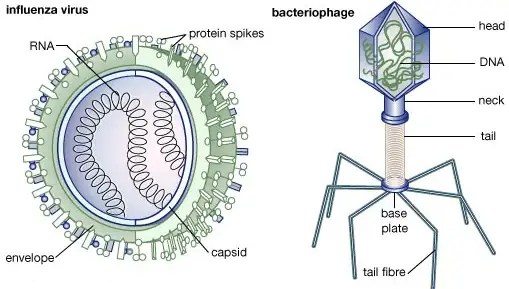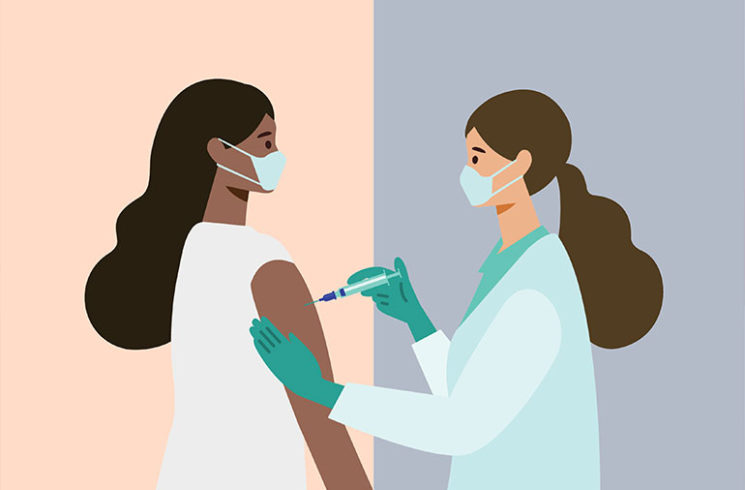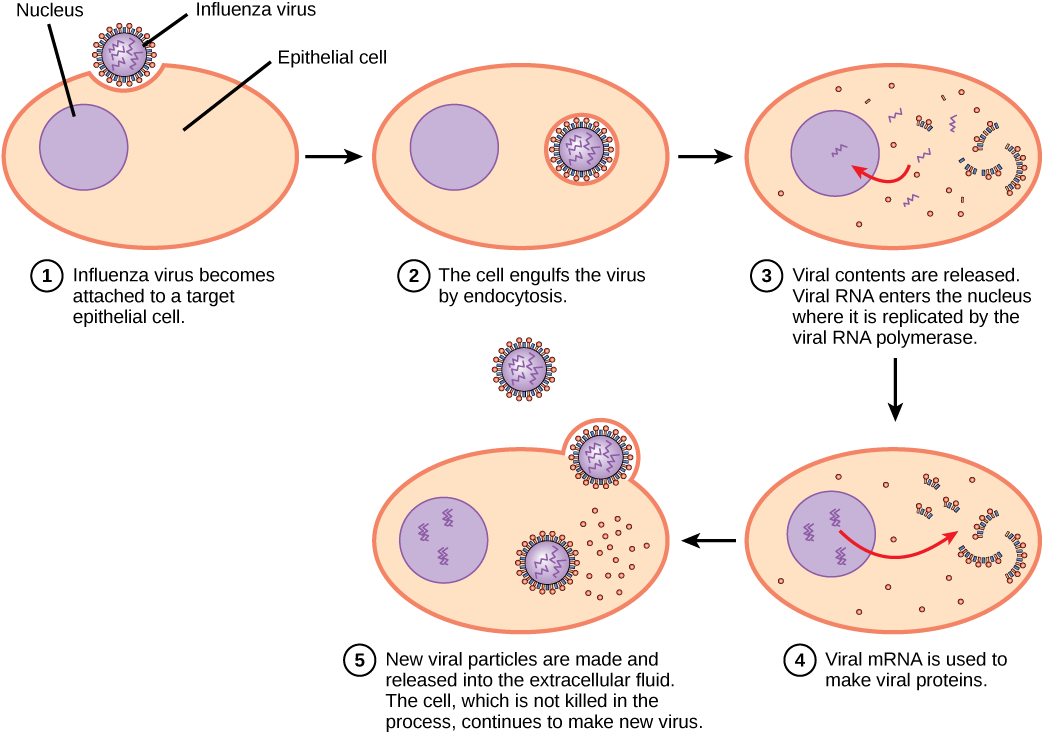Viruses: Overview and Characteristics Study Guide
Introduction:
Viruses are microscopic, infectious agents that infect all life forms. They do not have cytoplasm or organelles like those present in cells, making them acellular. Viruses cannot replicate independently and must depend on the host cell’s metabolic system. However, viruses do not increase or re-infect each other, and instead, new viral components are generated and assembled in the host cell to create the virus. Read on to learn more about viruses and their characteristics!
What are viruses?
When a virus enters a host cell, it is a non-cellular, tiny infectious agent. Biologically speaking, viruses are neither living nor non-living entities, and this is because they have some of the characteristics of both living and non-living things.
Components of viruses are non-cellular infectious agents composed of genetic material and protein and can replicate exclusively in living microorganisms such as bacterial, plant, and animal cells.

For example, a virus cannot reproduce outside of its host cell, and this is since viruses are deficient in the cellular machinery needed to function. Since the virus can invade a host cell, it injects its genetic material, reproduces using the host cell’s DNA, and then the cell cracks apart, releasing the new viruses.
Viruses may also be crystallized, which is something no other living entity can do. As a result of these features, viruses are placed in the grey region between living and non-living entities.
Structure of a Virus
Virus Components and their Functions
The structure of viruses ranges from 30 to 50 nanometres, making them very tiny. Additionally, these organisms lack a cell wall and have a protective protein coating known as a capsid, which often houses the genetic material. There are two types of genetic material in capsids: RNA and DNA.
The complex metabolic machinery of prokaryotic or eukaryotic cells, which viruses exploit for reproduction, mainly depends on their hosts. For the most part, a virus is designed to reproduce itself by infecting and transferring its DNA or RNA genome to host cells. Asymmetric protein has been used to encapsulate the viral DNA. One of the nucleic acid-associated proteins (sometimes referred to as nucleoprotein) is to produce the nucleocapsid containing the genome.
Essential characteristics of a virus
- Viruses are often thought of as non-living organisms. Viruses do not satisfy most of the requirements for life, and they aren’t even formed of cells, to be honest.
- A virus is a sub-microscopic particle that may infect live cells and spread throughout the body.
- Compared to prokaryotes, viruses are substantially smaller in size, typically ranging from around 20–300 nanometers (nm). A typical prokaryote measures length between 0.5 to 5 micrometers (m). If a virus was the size of three soccer balls placed next to each other, then a prokaryote would be the size of a massive ground.
- A virion is a name given to a single virus. In terms of size, it is a minuscule particle far smaller than a prokaryotic cell. Because viruses do not consist of cells, they do not have cell membranes, cytoplasm, ribosomes, or other organelles customarily found in cells.
- They cannot generate proteins or even reproduce on their own if they do not have these structures. Instead, they must rely on a host cell to create their proteins and replicate themselves, which is time-consuming.
- Although viruses are not considered living entities, they share two crucial characteristics with live organisms, and they possess genetic material and can develop.
The unique characteristics of viruses have thus been a source of contention, and it raises the issue of what it means to be alive in the first place.
-
Virus Microbiology studies the viruses are that infect and live within the cells of other living things. When viruses infect the cells of their host, they have the potential to cause illness. HIV (acquired immune deficiency syndrome), influenza (flu), chickenpox, and the common cold are all caused by viruses, as is HIV infection. When it comes to viral illnesses, treatment might be challenging at times.
-
The use of antibiotics has little impact on viruses, and there are only a few antiviral medications available for specific conditions. One of the most effective methods of preventing viral illnesses is vaccination, which results in the development of immunity. However, vaccinations are only accessible for a small number of diseases.
Reproduction
All viruses need a host cell to reproduce, and they can’t produce alone. Viruses are genetic strands enclosed in a protective protein covering a capsid, and they infect both eukaryotes and prokaryotes. They multiply within the cell using ATP, ribosomes, enzymes, and other biological components.
Habitat types
Viruses live in practically every form of life, including prokaryotes.
- A phage infects prokaryotes.
- Phages are thought to be more prevalent than prokaryotic creatures in the biosphere. Phages live in dirt, animal intestines, and the ocean.
- A milliliter of saltwater contains up to 109 virions, and phages infect up to 70% of marine bacteria.
- They are present in water and certain foods, such as fermented vegetables and meats, where they inhibit bacterial development.
Conclusion:
- Viruses are microscopic particles, even smaller than prokaryotic cells, making them difficult to detect.
- Viruses are not cells and therefore can reproduce independently without assistance; yet, they contain nucleic acids and may develop.
We hope you enjoyed studying this lesson and learned something cool about viruses- overview and characteristics! Join our Discord community to get any questions you may have answered and to engage with other students just like you! Don’t forget to download our App to experience our fun, VR classrooms – we promise, it makes studying much more fun! 😎
FAQs:
1. What is a virus’s main goal?
The primary purpose is to insert its genome into a host cell for expression (transcription and translation). A virion is a virus that has been built from the ground up.
2. Can a virus reproduce?
A virus can only replicate in uninfected cells. The host cell gets transformed into a viral factory due to this reprogramming.
3. What is a virus in simple words?
A virus is a parasite that may infect living creatures and cause sickness. It can replicate inside another organism’s cells. They are made up of DNA, and a protein is covered. It’s usually RNA, but it’s sometimes DNA.
4. Which is true about viruses?
Viruses are not considered animals since they cannot reproduce or perform metabolic tasks without a host cell. Viral nucleic acids and RNAs are made up of protein and nucleic acid.
5. Is a virus an organism?
Viruses are microorganisms that can only reproduce in host cells. It takes a standard optical microscope to view most viruses at all. All organisms are susceptible to viruses, including humans, plants, and microorganisms.
We hope you enjoyed studying this lesson and learned something cool about the Viruses – Overview and Characteristics! Join our Discord community to get any questions you may have answered and to engage with other students just like you! Don’t forget to download our App and check out our awesome VR room for this guide – we promise it makes studying much more fun 😎
Sources:
- Virus Characteristicshttps://www.ck12.org/book/ck-12-biology-concepts/section/7.9/ Accessed on 7 Dec 2021
- General Characteristics of Viruses. https://bio.libretexts.org/Bookshelves/Microbiology/Book%3A_Microbiology_(Kaiser)/Unit_4%3A_Eukaryotic_Microorganisms_and_Viruses/10%3A_Viruses/10.01%3A_General_Characteristics_of_Viruses Accessed on 7 Dec 2021



